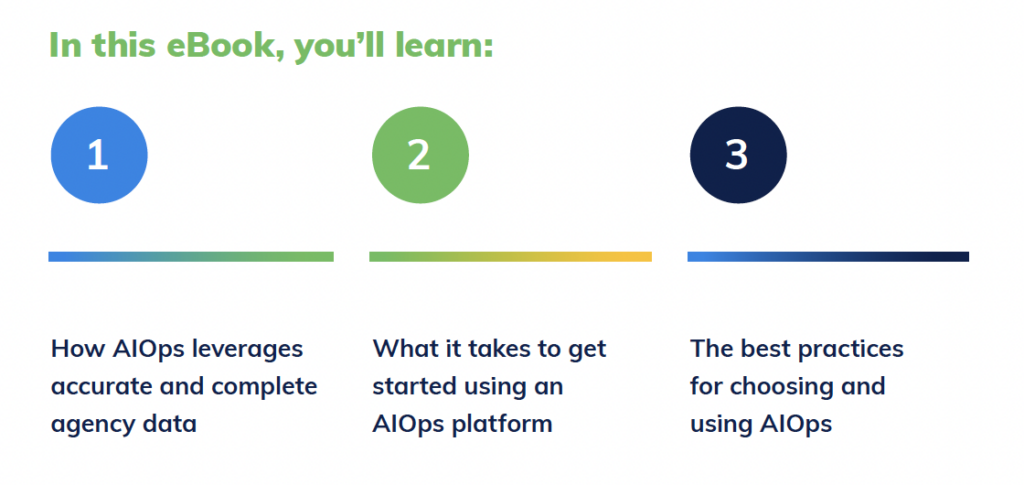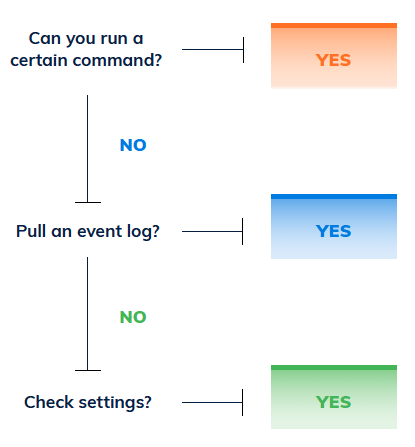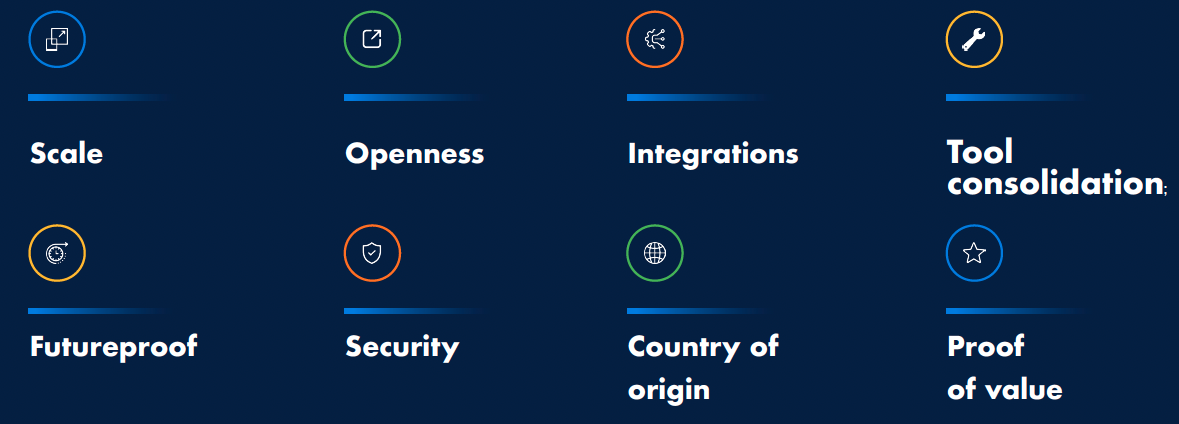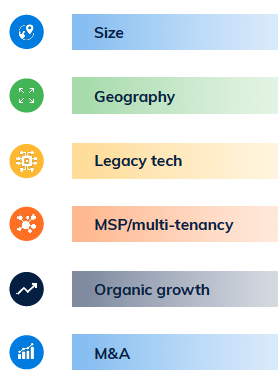Introduction
Gartner defines AIOps as “the application of machine learning and data science to IT operations problems.” That simple description belies a lot of complex engineering that allows AIOps platforms to combine big data and machine learning to produce a platform that gives IT operations staff the power to automate decision making and many manual tasks, allowing organization to maintain their IT estates at a high degree of efficiency and reliability.
When fed complete, accurate agency data, AIOps can streamline—and even automate—processes like event correlation, root cause analysis, preventative maintenance, incident detection and systems restoral, and decision making that once consumed most of an IT operations team’s time. What’s more, as IT estates grow more complex and generate an exponentially greater volume of data, humans simply can’t keep up. AIOps platforms like ScienceLogic’s SL1 give organizations a tool for handling data and IT operations management in real-time, and at unparalleled accuracy.
That’s why the market for AIOps is expected to grow to over $27 billion within five years as more organizations choose AIOps as their catalyst for IT transformation. But smart organizations don’t invest in technology because it’s trendy; they invest in technology because it works. This ScienceLogic eBook helps you to set a path to put AIOps to work for your agency by helping you to understand how AIOps works, learn how to put AIOps to work for your agency, and establish proven best practices for AIOps success.

Part One: How AIOps Leverages Complete & Accurate Agency Data
 AIOps platforms, combine big data and machine learning functionality to enhance and partially replace all primary IT operations functions, including availability and performance monitoring, event correlation and analysis, and IT service management and automation. AIOps platforms consume and analyze the ever-increasing volume, variety and velocity of data generated and present it in a useful way.
AIOps platforms, combine big data and machine learning functionality to enhance and partially replace all primary IT operations functions, including availability and performance monitoring, event correlation and analysis, and IT service management and automation. AIOps platforms consume and analyze the ever-increasing volume, variety and velocity of data generated and present it in a useful way.
There’s a lot to that description. It helps to think of AIOps as a relatively new term for the latest phase in the evolution of IT operations monitoring and management. It’s what IT management teams have been asking for ever since the advent of Big Data, when the speed and complexity of the IT estate surpassed the ability of humans to keep up. And for organizations that have invested in the technology, AIOps means something else: automation. Specifically, with AIOps IT operations teams can automate the processes that enable them to See, Contextualize, and Act on events in their environment.


AIOps’ Virtuous Data Cycle
Delivering reliable IT process automations requires complete, accurate, and real-time data. That is only possible through comprehensive discovery of all systems, services, and applications operating in the IT estate. The SL1 AIOps platform is engineered to provide visibility across the entire agency, including legacy systems operating on-premises and assets operating in the cloud.
Discovering all an agency’s network elements in real-time, consolidating and contextualizing in a single operational data lake, and applying that data to improve performance creates a virtuous cycle that ensures infrastructure health, availability, and reliability are always operating at maximal efficiency.


Data Is the Foundation
Data is the foundation of automation with AIOps, but “garbage in, garbage out” applies to the data used to support automation. When data is erroneous, incomplete, or obsolete, there is no way to ensure automated processes will be successful But with SL1, IT operations teams can collect data from all sources, consolidate data in a single operational data lake, contextualize the data by identifying dependencies, use the data to generate meaningful insights, and then apply those insights to automate valuable IT workflows.
Large Enterprise Case Study
One large high technology manufacturing agency, using mostly legacy tools and manual labor to “keep the lights on,” were determined to transform their approach to IT operations by leveraging the ScienceLogic SL1 AIOps platform to streamline operations and enable automation. Using a crawl, walk, run approach to demonstrate what’s possible and build confidence.
The results were massive gains in efficiency and reliability, including:
5900% Mean Time to Resolution (MTTR) improvement;
45% of incidents automatically triaged and resolved; and Operations productivity increases saving the company tens of millions of dollars.
Part Two: What It Takes to Get Started Using an AIOps Platform
 Data is king in AIOps. As discussed in Part One, it’s a foundational requirement for managing IT operations and automating IT workflows. But achieving success with AIOps requires the right platform (SL1 for instance) and a planned approach to ensure your platform can discover all assets and to ingest all operational data. That includes things like log data, availability data, relationship data (which is often huge), performance data (“speeds and feeds”), and any variances of that same data. Once discovered and ingested, you can create an accurate topology” “of the infrastructure environment that allows you to evaluate the data through machine learning analytics to detect anomalies, understand root cause, and produce and automate actionable events.
Data is king in AIOps. As discussed in Part One, it’s a foundational requirement for managing IT operations and automating IT workflows. But achieving success with AIOps requires the right platform (SL1 for instance) and a planned approach to ensure your platform can discover all assets and to ingest all operational data. That includes things like log data, availability data, relationship data (which is often huge), performance data (“speeds and feeds”), and any variances of that same data. Once discovered and ingested, you can create an accurate topology” “of the infrastructure environment that allows you to evaluate the data through machine learning analytics to detect anomalies, understand root cause, and produce and automate actionable events.
A good AIOps platform is not merely a monitoring and management tool; it is a journey to IT operational efficiency. And as with any journey, you have starting point, and from there chart a course to your destination. Here’s what it takes to get started with AIOps:


Data Integrations
Beyond discovery of the systems, services, and applications that comprise your IT infrastructure, an AIOps platform needs tight integrations with the data platforms you rely on to manage your agency, feeding them the clean data they need to perform at their best. There are common integrations with IT operations management (ITOM), IT services management (ITSM), application performance monitoring (APM), Security Information and Event Management (SIEM), and configuration management database (CMDB) vendors. These are table stakes for any AIOps platform.
But to be truly useful and support the full scope of IT operations, an AIOps platform must be able to integrate with every element of data flow across your IT environment. Only through deep visibility across all your technologies, applications, and services can you ensure consistent data across your management ecosystem and reliably automate IT workflows to keep pace with your business. That’s why SL1 offers more than 500 out-of-the-box PowerPack integration.
Executing Data Triage
When dealing with data at the speed and volume typical with a modern agency, the resulting increase in trouble signals can make people fearful that they will be overwhelmed. To prevent this from happening requires data triage that automatically eliminates redundant signals, identifies harmless anomalies, and prioritizes events that need attention while also providing vital insights—like root causes—through event enrichment.
With AIOps, when an event occurs it triggers a series of decisions and actions prebuilt into the system, including automations that can eliminate human intervention. For example, an event might prompt a several questions intended to diagnose a problem and its solution: Can you run a certain command? Pull an event log? Check settings? With SL1 all those steps and more can be triaged and automated, doing in moments what a human might take 30 minutes or more to accomplish.
SL1 Automated Triage



System Self-Healing
Ultimately, the ideal for automating IT workflows with AIOps is to achieve system self-healing. That means when X happens, AIOps automatically diagnoses and resolves the issue, and restarts the service. It also means that when a provisioning system spins up an additional instance, all the downstream effects are understood and accounted for. For example, load balancing when a service migrates from host Y to host Z and automatically changing DNS settings, etc.
Any time a ticket is opened, enrichments are run-stamped on the ticket, changes are made based on the even. Then, the incident is resolved, and the ticket closed without a human ever having touched it. And because these things are done without human intervention, they are not only faster, but the risk of human error is minimized.
Each decision is made through advanced analytics and with a complete, contextual understanding of the related impacts.
With system self-healing, the agency can operate at full potential and employees, customers, and partners benefit from service availability. The results? Happy employees, satisfied customers, and a reliable digital supply chain.
Furthermore, the results inform the virtuous cycle of See, Contextualize, and Act, meaning ongoing process improvements occur as conditions change. And because AIOps generates and captures a complete audit trail in the ITSM system, the resulting insights are available to drive other decisions like lessons learned, postmortem discussions, and resource allocation.


Data Democratization
Another important aspect of an AIOps platform is the ability to transcend data’s utility specific to the organization. Once data resources are discovered, dataflows ingested, and all data normalized in a single, unified data lake, that data must be rendered in a way that makes sense to organization using it. That means it must do more than merely support IT operations, but also be available and intuitively useful to carrying out the organization’s mission and support the roles of individuals and departments within the organization. In other words, AIOps must support the organization’s goals through data democratization.
SL1 does this by defining the data it ingests and adding the context necessary to help its machine learning algorithms understand relationships not only associated to what box speaks to what box, but also how those flows come together to support a certain mission or business function.


Security-by-Design
Finally, because your AIOps platform plays an integral role in the movement of data—including data relevant to network, system, and component performance—it’s important that your chosen technology be engineered to be secure. SL1 by ScienceLogic is built with a security-by-design approach and tested rigorously. In fact, SL1 is certified by the Department of Defense Information Network (DoDIN) for operating in the most sensitive IT environments in the U.S. federal government—including infrastructure used for classified information and managed by the Defense Information Systems Agency (DISA).
Public Sector Case Study
In 2019, one of the largest federal agencies in the U.S. had to implement a near overnight shift to a remote work model because of Covid-19. The agency’s network was already vast and complex, with 200 development projects and 1.5 million data elements operating across more than 1,200 locations at any time. And because the agency supports more than 19 million constituents, including health services delivery, the shift created a critical strain on bandwidth, service, and application performance.
Fortunately, the agency had already begun an IT modernization journey, including ScienceLogic’s SL1 AIOps platform. However, because of the pandemic a planned years-long process had to” “be compressed into a matter of weeks. Instead of the usual crawl, walk, run approach, the agency had to go into a full sprint. The agency started by moving one of its largest and most mission critical systems to the cloud. That system included a major web-based application supporting about 4000 simultaneous users and managing millions of digital documents.
SL1 was essential to this customer for ensuring the success of their massive hybrid cloud environments. They leverage our platform to for monitoring performance and diagnosing issues as they occur. Upon completion, the project manager described the result as a “technical miracle.”
Part Three: Best Practices When Choosing and Using AIOps
AIOps is often referred to in generic terms, and many vendors claim to offer AIOps but without the full scope of features and capabilities true AIOps demands. An AIOps platform like SL1 from ScienceLogic is a powerful and highly capable IT monitoring and management technology that is at its best when applied to the specific needs of an IT environment. It is not a rigid tool that demands the user make accommodations to fit its limitations, but one that adapts to the needs and data specific to the user. Each data lake created by SL1 is unique to its agency, with contents normalized for accomplishing the organization’s mission.
That said, there are several best practices that should be followed to get the most out of any investment in AIOps. These are best understood in the context of matching the needs of an organization with the platform’s capabilities in areas like:

Let's examine each a little more closely.
Scale
 Scale may be the most important consideration if your organization is large and complex. Some AIOps platforms are engineered to work well for smaller agencys, but performance rapidly diminishes when deployed within larger IT environments, or when in instances when the scope includes multi-tenant applications (such as
Scale may be the most important consideration if your organization is large and complex. Some AIOps platforms are engineered to work well for smaller agencys, but performance rapidly diminishes when deployed within larger IT environments, or when in instances when the scope includes multi-tenant applications (such as
with MSPs) or for organizations distributed geographically.
With this in mind, it’s important to not only evaluate your needs based on the current size of your IT estate, but whether plans include significant growth, either organic or through acquisition. With the latter, your AIOps platform may need to support not only a sudden increase in scale, but the infrastructure that comes with it.
Openess
Today’s agencies rely on a variety of technologies old and new, and it’s important that your AIOps platform be able to play nice with them all. That means supporting the same systems you are likely to encounter in whatever environment you find yourself in. AIOps platforms that don’t support the widest variety of technologies—including legacy systems, cloud tech, software-defined service, and more—are of limited value.
Integrations
Related to openness, technology integrations are vital to maximizing the value of your investment in an AIOps platform. When evaluating your choices, it helps to take an inventory of the systems and tools your IT operations team already relies on. From there you can better determine whether a particular platform will be ready “out-of-thebox,” of if there will be a significant amount of customization required.
Fortunately, ScienceLogic’s SL1 AIOps platform already supports all the popular ITSM, ITOM, CMDB, APM, and SIEM vendors. And with more than 500 additional integrations available through PowerPacks, ScienceLogic supports the industry’s widest variety of technologies.
Tool Consolidation
Tool consolidation is not a primary function of an AIOps platform, but the last thing your agency needs is more complexity. If your AIOps platform contributes to complexity by adding another tool to an already crowded box, you may want to reconsider. As a byproduct of adopting AIOps— and specifically SL1 from ScienceLogic—you should expect to be able to eliminate many legacy IT monitoring tools. And while there may be a need to maintain some functional overlap, SL1 can deliver “single pane of glass” dashboard visibility and control for the tools you are running.
Futureproof
An important question to ask yourself when evaluating AIOps is, “Can I get a platform that supports my needs today?” Then follow that up with, “Will this platform meet my needs tomorrow?” While it is difficult to predict what the future holds, a vendor that has a track record of evolving with the changing technology landscape is important. ScienceLogic has an exceptionally good 20-year record of anticipating trends and seamlessly adapting to change. SL1 is engineered that way. We can support mainframes, Kubernetes containers, and everything in between with the same platform. And our growing array of 500+ integration PowerPacks ensures that our customers can keep pace with change.
Security
No AIOps platform can be accurately described as a security product, but every AIOps platform should be a secure product. SL1 is. Our security-by-design approach, affirmed by our certification by the Department of Defense Information Network (DoDIN), means it can be trusted in commercial environments. What’s more, by integrating with security tools like security incident and event monitoring (SIEM) platforms, SL1 can complement cybersecurity programs by providing clean, timely data for analysis in search for indicators of compromise, or erroneous settings that could put the agency at risk of a breach or leave it vulnerable to attack.
Country of Origin
Although this best practice may not be universally applicable, for organizations that work with the U.S. federal government— or plan to—there may be a need to comply with regulations requiring that core technologies be sourced and developed by American vendors. ScienceLogic is a U.S. company, and SL1 is developed here. Furthermore, SL1 is DoDIN certified, approved for use in classified environments, and on the federal Approved Products List (APL) catalog.
Proof of Value
As a software solution, AIOps platforms are easy to demonstrate. And when evaluating your choices, a vendor should be able to demonstrate their platform within a customer environment. You should always ask for a demonstration within your environment so that you can see proof of value (POV) and get a sense of how the platform will work for you. Generalized descriptions of functionality may be helpful when a conversation begins, but there is no substitute to seeing a solution in action and in a context that is meaningful to the user.
Any AIOps vendor should be able to conduct such a demonstration, so come prepared with questions specific to your situation and ask to see the platform at work in response. Here are a few questions that can help to separate AIOps contenders from the AIOps pretenders:
Conclusion
An investment in AIOps is a major undertaking. It often precedes an organization’s technology transformation and is a pivotal piece in enabling high value IT workflow automations, maximizing service efficiency, and improving the health, availability, and reliability of IT operations. ScienceLogic’s SL1 AIOps platform is recognized by industry analysts and many of the world’s largest, most complex agencies as the best option in the industry.
ScienceLogic and SL1 offer:
- Excellent customer and technical support
- A full scope of integration
- Security by design
- Ease-of-use, and
- Built to last
Our technology, experience, and expertise are without peer in our industry.
Advance Your Mission with AIOps
Build a business case: Investing in AIOps requires strategic planning and a strong business case. Our AIOps Value Calculator is intended to help companies demonstrate, justify, and realize the tangible value of IT investments to key business stakeholders. Prove why investing in AIOps is a no-brainer for your organization.
Choose an AIOps solution: There are a great deal of AIOps solutions on the market today. Before locking in on a solution, be sure you have a thorough understanding of the different types of solutions, the time they take to implement, as well as the overall time and effort needed to maintain. If you’re still unsure which AIOps solution is right for you, check out the latest AIOps Forrester Wave report.
Ready to see AIOps in action? We offer product tours to give you a self-service experience to see firsthand how ScienceLogic can help your organization tackle the most complex IT challenges. Get started on your AIOps journey today by signing up for a personalized demo.





